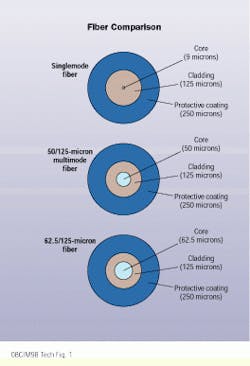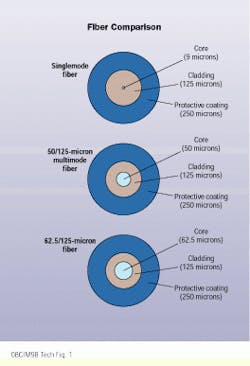50-micron fiber gets a second glance
The sleeping optical giant receives a wake-up call as Gigabit Ethernet requirements come into focus.
Patrick McLaughlin
For years, glass optical fiber generally has been categorized into two groups: singlemode and multimode. Singlemode fiber has a core diameter of approximately 9 microns and can accommodate signal transmission down a single path (mode) of light--hence the name, "singlemode." Multimode fiber gets its name from its ability to accommodate signal transmission down several modes of light. Both types of fiber have outside diameters of 125 microns. Although multimode fiber is manufactured in 50- and 62.5-micron core sizes, most multimode fiber cabling deployed in North American local area networks (lans) contains 62.5/125-micron fiber.
However, the near saturation of the fiber-cabling market by 62.5/125-micron fiber may soon change because technological issues related to high-speed transmission are forcing fiber, cable, and component manufacturers, as well as end-users, to take a closer look at the performance of 50- and 62.5-micron fiber.
Historical perspective
One of the most significant reasons that 62.5-micron fiber cable has been the runaway favorite as a fiber-optic medium for North American lans is the fiber`s numerical aperture (NA), which expresses the fiber core`s ability to accept and propagate light. The higher the NA, the more light the fiber will accept. And the bigger the core, the higher the NA. So a 62.5-micron fiber can accept more light than a 50-micron fiber.
The NA value is significant when signals are generated by light-emitting diodes (LEDs), which for years, were the only alternative to more-expensive lasers and the only signal-generating technology used in short-wavelength (850-nanometer) fiber transmission. Because a 62.5-micron fiber was better at accommodating the signal generated by an LED, it was the logical choice for fiber-optic transmission. In fact, the TIA/EIA-568a Commercial Building Telecommunications Cabling Standard specifies 62.5-micron fiber as a viable cabling medium but does not mention 50-micron fiber.
Failure to appear in the TIA/EIA-568a standard effectively seaLED 50-micron fiber`s fate--at least temporarily. The medium has been deployed in military applications in North America and in commercial applications outside the continent, but few North American commercial deployments exist.
A fresh look
The industry moved along for several years without giving much thought to 50-micron fiber, until recent activity by the body responsible for drafting the Gigabit Ethernet standard brought some attention to it. The 802.3z committee of the Institute of Electrical and Electronics Engineers (IEEE--New York City), which has put together specifications for running Gigabit Ethernet traffic over fiber-optic cable, included both 50- and 62.5-micron multimode fiber as well as singlemode fiber in the specifications.
The decision to include 50-micron fiber in the specification is not surprising, considering that Gigabit Ethernet will be deployed worldwide and that the rejection of 50-micron fiber is in reality a North American phenomenon. However, what the 802.3z committee discovered when it was testing Gigabit Ethernet over both types of multimode fiber did surprise some, who began pay-ing attention to the smaller-core multimode fiber for the first time.
NA becomes N/A
What happened was that during the years that the North American premises wiring market was passing over 50-micron fiber, vertical-cavity surface-emitting laser (vcsel) technology was being developed and deployed for 850-nm transmission. For years, the high NA of 62.5-micron fiber helped compensate for some transmission inefficiencies inherent in LEDs, according to Tony Beam, registered communications distribution designer (rcdd) and director of premises systems marketing with amp Inc. (Harrisburg, PA). Now, with more-efficient vcsel technology in place, that compensation is no longer necessary, so a multimode fiber`s NA is insignificant. "VCSEL technology has eliminated the significance of numerical aperture as a physical characteristic in multimode fiber," he says. "Also, the limitations of LEDs have been recognized in the past several years. For transmission of data at any rate faster than 622 megabits per second, LEDs suffer."
The upshot of these two facts is that vcsels, not LEDs, will be used in gigabit transmission, and 62.5-micron fiber holds no advantage over 50-micron fiber in such high-speed networks.
In fact, testing has shown that 50-micron fiber offers some advantages over its larger-core counterpart. "It is superior to 62.5-micron fiber," says Eric Pearson, certified professional consultant and president of Pearson Technologies (Atlanta, GA). "The smaller numerical aperture actually allows 50- micron fiber to support higher bandwidth than does 62.5- micron fiber when lasers are used."
One context in which the differences between the two multimode fiber types have been realized is the distance specifications that the IEEE 802.3z committee has put forth in the Gigabit Ethernet standard. "As the Gigabit Ethernet standard has evolved," Pearson says, "the distance specifications have become a point of focus."
Steven Swanson, standards engineering manager with optical-fiber manufacturer Corning Inc. (Corning, NY), has made several presentations to the 802.3z committee as the group has worked to finalize appropriate distance specifications for 50- and 62.5-micron fiber.
"The committee`s original intent was for both types of multimode fiber to support 500 meters," he says. He points out that this distance is a logical choice because it is specified as the maximum backbone distance in both the TIA/EIA-568a standard and the ISO/IEC-11801 international cabling standard, established by the International Organization for Standardization (iso--Geneva) in conjunction with the International Electrotechnical Commission (iec--Geneva).
"It`s also important to remember that the distances put forth by the Gigabit Ethernet committee are the minimum distances that a medium can support," Swanson continues. "In terms of fiber performance, these distances represent worst-case scenarios."
The committee has specified several distance measurements for each type of multimode fiber. Both 50- and 62.5-micron fiber support minimum distances of 550 meters in long-wavelength, 1300-nm Gigabit Ethernet transmission. However, 50-micron fiber also supports 550-meter distances in the 850-nm operating window, where 62.5-micron fiber supports only 220 meters.
"Through field testing, the group discovered that some 50-micron fiber with a bandwidth of 400 megahertz-kilometers exists in the instalLED base," Swanson says. "So the committee added that bandwidth to the specification." The group established distances of 500 meters for this fiber type in the 850-nm window and 550 meters in the 1300-nm window.
The group also recognized 62.5-micron fiber with a bandwidth of 200 MHz-km. It specified a 275-meter distance for the medium in the 850-nm window and a 550-meter distance in the 1300-nm window.
Swanson notes that these specifications have prompted some discussion about the realistic distance needs of end-users. "There has been a lot of debate around the issue of building structures and building sizes and how far cabling actually runs within a local area network," he says. "But two of the most commonly cited standards--TIA/EIA-568a and ISO/IEC-11801--both specify 100 meters of horizontal cabling, 500 meters of building backbone, and 1500 meters of campus backbone. Five hundred meters will encompass a high percentage of building backbones," he says.
He also points out that manufacturers in the fiber-optics industry have promoted a centralized network architecture, in which the distinction between backbone and horizontal cabling is not always clearly defined.
Market reaction
AMP and 3M Telecom Systems Div. (Austin, TX) both offer 50-micron fiber in their recently introduced end-to-end fiber-optic cabling systems. amp`s Solarum system is available in 50-micron multimode, 62.5-micron multimode, and singlemode versions; 3M`s Volition system comes in 50- and 62.5-micron multimode versions, with a singlemode version expected by year-end.
At a recent meeting, a Telecommunications Industry Association (TIA--Arlington, VA) working group accepted a pro-posal to include 50-micron fiber in the next version of the TIA/EIA-568a cabling standard, which will be labeLED TIA/EIA-568b and may go out for initial ballot by year-end.
Eric Pearson believes that having a choice between two types of multimode fiber may complicate matters for end-users. "The problem is that there`s a huge installed base of 62.5-micron fiber. Some people may want to mix both types of multimode fiber in a single system, which would cause problems."
AMP`s Beam says that education is key: "Vendors in the fiber-optics industry as well as the trade press must educate consumers with the correct, truthful message. We must minimize or eliminate confusion for the user, who now has a choice that wasn`t offered before." Beam adds that the two media will coexist in the market for some time: "Fifty-micron fiber is the best medium to use for new fiber systems. But those who have already installed 62.5-micron fiber should not feel like they have to upgrade to 50-micron. The 62.5-micron fiber can still handle the applications widely in use and will support Gigabit Ethernet up to certain distances."
This diagram shows the difference in core diameters among singlemode, 50/125-micron multimode, and 62.5/125-micron multimode fiber. The core is the information-carrying part of the fiber.

